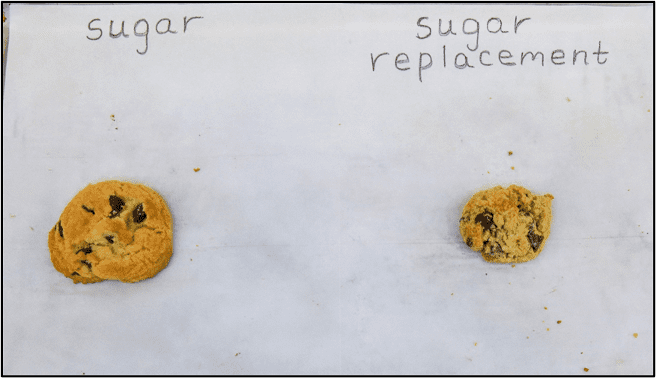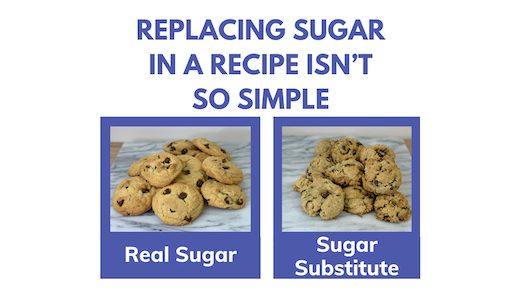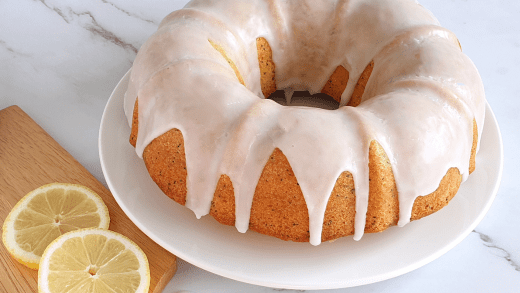By: Demi Striglos
Sugar is considered a vital ingredient in baking and cooking. In baked goods, it is common knowledge it adds that sweet taste we love, but sugar provides a lot more than just a sweet flavor to baking. It affects a baked good’s moisture level, texture, consistency, how long the good stays soft and adds color. (Find an in-depth look at those scientific functions here.)
It is increasingly common to see alternatives or replacement options for staple ingredients in grocery stores and notes about how to substitute ingredients when looking for recipes online. The use of alternative sweeteners in place of sugar in packaged foods and beverages has increased a lot in the past five years. And you may have even tried one substitute or another in a recipe at home.
We put this to the test, baking a classic chocolate chip cookie recipe twice, once using classic, real sugar and then again using a sugar substitute that is available in mock granulated and brown sugar crystals.
Making the dough
The first step in the recipe was to cream together the butter, granulated sugar, and brown sugar. Real Sugar Batch: The three ingredients came together easily with a hand mixer leaving a light-colored creamy batter. Sugar Substitute*: The ingredients came together with the same ease as the real sugar but not as creamy nor as light of a color.
Next, I added the eggs, vanilla, and baking soda to the butter mixture. Real Sugar: These ingredients mixed smoothly and left the result creamy still.Sugar Substitute*: The ingredients did not mix well and the dough was quite grainy.
Finally, I stirred in the flour and then chocolate chips. Real Sugar Batch: The flour blended into the mixture easily and the chocolate chips were distributed evenly and stuck in the dough in no time.Sugar Substitute*: The flour was very difficult to stir into the mixture along with the chocolate chips. The chocolate chips did not stick into the batter and had to be pressed into the dough balls.
Overall, the texture of the real sugar vs. sugar substitute dough was very different. The dough with the substitute was quite lumpy and visibly dry and the chocolate chips had to be pressed into the balls of dough.
 Real Sugar
Real Sugar Sugar Substitute
Sugar SubstituteBaking
Using a medium cookie scoop, I dropped the dough balls onto the parchment paper-lined baking sheet.Real Sugar: The dough was easy to scoop and kept its shape well.Sugar Substitute*: The dough was significantly less creamy and proved hard to form into balls. It was also difficult to get a dough ball with evenly distributed chocolate chips without overhandling the dough.

I baked the cookies at 350 degrees for 14 minutes. Real Sugar: The dough spread evenly, getting slightly crispy on the edges. When finished the cookies were a fluffy looking golden brown. Sugar Substitute*: The dough did not spread at all while in the oven and came out appearing chalky and dry with light brown color.

Real Sugar: The cookies had a buttery sweet flavor and a soft middle with an overall moist consistency.Sugar Substitute*: The shape of the cookies was the exact same as the dough ball prior to baking. They were very dry and crumbly with a harder consistency and texture compared to the real sugar batch. They resembled and tasted more like a tea cookie or a scone than the desired classic homemade chocolate chip cookie.

At the end of the day, sugar can’t simply be substituted in chocolate chip cookies and yield the same result. Substituting sugar only saves 30 calories per cookie. Based on this recipe, a cookie made with real sugar contains 149 calories and the cookie containing the sugar substitute is 119 calories.
A Few More Tests
We also made Sally’s Baking Addiction’s vanilla cake and New York Times’ simple BBQ sauce with real sugar and a sugar substitute to test the difference. Like the chocolate chip cookies, the results were not the same. The moisture, texture, color, aroma or taste was always off depending on the recipe.
Vanilla Cake
Real Sugar: The color of the cake exterior was a consistent golden brown all over and it was darker than the cake made with a sugar substitute. The texture was soft and moist and offered a slight bounce when poked.Sugar Substitute*: The color was lighter than the cake made with real sugar, but the walls were much darker, almost burnt looking. The texture was very hardon the outside and offered no movement when poked. The inside was dry.
BBQ Sauce
Real Sugar: The texture had a smooth consistency and the sauce had a strong smell of the spices in the recipe.Sugar Substitute*: The texture was slightly lumpy and poured from the jar in clumps instead of a steady stream. The sauce had a strong aroma of sour vinegar.
*The sugar substitute used was a mixture of erythritol and oligosaccharides.




Get Social with #MoreToSugar